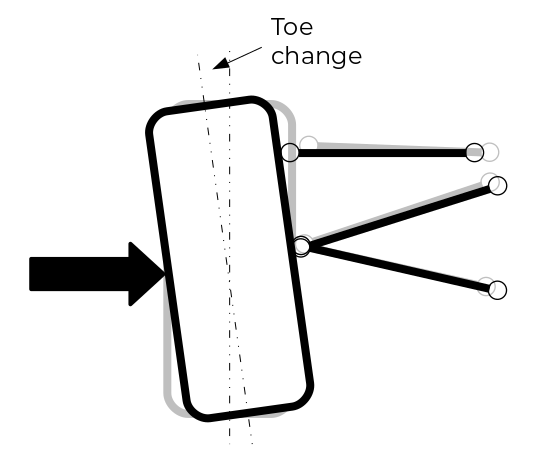Compliance steer is a metric to measure the amount of self steer generated by a suspension system when it is subject to a cornering (lateral) load at the contact patch. Compliance steer is measured as degrees of toe change per Kilo-Newton of force at the contact patch, Deg/kN.
On all production cars compliance steer gives an understeer tendency from the suspension (toe out on the front axle and toe in on the rear axle). Most mainstream production cars have lateral compliance steers somewhere between ~0.1 – 0.2 Deg/kN. Below ~0.05 Deg/kN would be considered a low level for a production car.
Suspension compliant understeer is only part of the vehicle understeer/oversteer story. Tyres and mass distribution also play major roles. This is a topic that will be looked at in more detail in a future post.

When designing a suspension system, it can be difficult to decouple compliance steer from camber compliance. In the case of compliance steer, the system needs to be reasonably soft to deliver a level of understeer from the suspension, on the other hand, low camber compliance requires a stiff suspension system. In mainstream production cars, this compromise almost always favours compliance steer as it ensures that the car has a sufficient level of understeer to be safe for all potential customers. As a results camber compliance is very often compromised. The results is a safe car with lots of understeer but with compromised handling, steering feel and agility.
That said, like bump steer, lateral compliance steer is not something which should be eliminated completely from a suspension system. Some level of understeer is good in a suspension system. Cars people drive on a daily basis have inherent understeer designed in. This is a behaviour we are all familiar with and have become accustomed to. Therefore driving something with no understeer or inherent oversteer would feel unnatural, too agile and too responsive.
Lateral compliance steer is also key to ensure the car feels stable and less nervous at high speed. This means that even high performance sports cars with >200mph top speeds have relatively high levels of lateral compliance steer while still delivering excellent handling, steering feel and agility. For cars like this, some clever engineering is required to increase compliance steer without increasing camber compliance.
—
